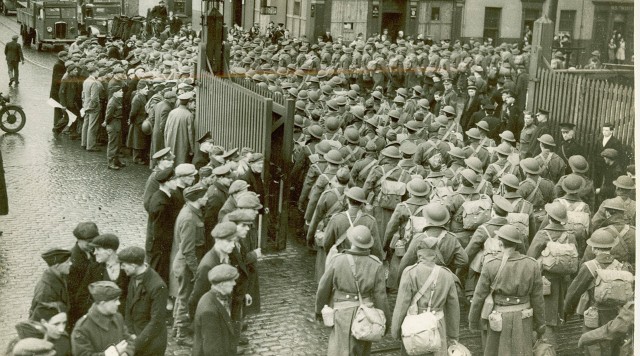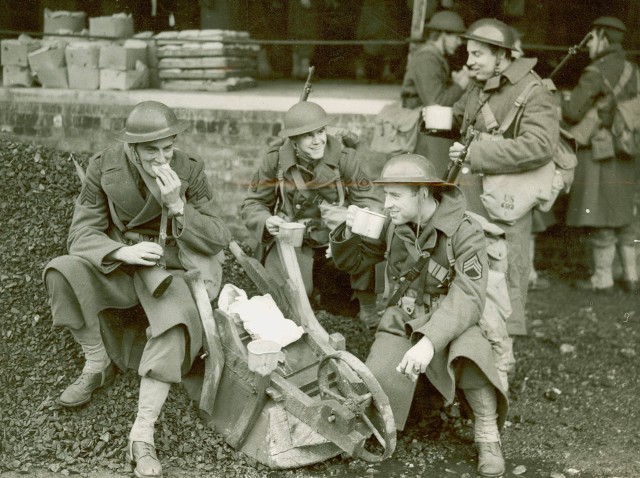The year 1940 marked a difficult period for Britain and several European countries, as the Third Reich continued to expand throughout Europe. In April Germany invaded Denmark and Norway. A month later The Netherlands, Belgium, and Luxembourg faced the German onslaught. June brought with it the stunning fall of France. A month later the Battle for Britain commenced, as the world awaited the anticipated German cross channel invasion.
In the face of unrelenting German successes, the United States Congress passed a Joint Resolution on August 27, 1940, ordering the entire National Guard to active duty for twelve months. One of the National Guard divisions mobilized was the 34th ("Red Bull") Division composed of units from Iowa, Minnesota, North Dakota, and South Dakota. It was originally scheduled for induction into federal service in October 1940, but due to a lack of adequate accommodations, that date was cancelled. Ultimately, the division was alerted for induction nine times, with each alert being cancelled. Finally, on February 10, 1941, the division, still organized as a World War I-era square division of four infantry regiments, was activated at Council Bluffs, Iowa. Ten days later, relying on both rail assets and truck convoys, the division moved to Camp Claiborne, Louisiana,. Once established in its tent city, the unit underwent intensive training and later successfully participated in the Third Army's Louisiana Maneuvers.
Because of its outstanding performance during the maneuvers and its advanced state of training, the 34th Division was selected as the first American contingent to cross the Atlantic and enter what would eventually become the European Theater of Operations. On January 26, 1942, just six weeks after Pearl Harbor, over 4,000 personnel, primarily from the "Red Bull" division, arrived at Dufferin Quay, Belfast Harbor, Belfast, Northern Ireland. As the troops disembarked from the British transport HMTS Strathaird and the American transport USAT Chateau Thierry, they were greeted by a formal delegation consisting of the Governor General (the Duke of Abercorn), the Prime Minister of Northern Ireland (John W. Andrews), the Commander of British Troops in Ulster (General G. E. W. Franklyn), and the Secretary of State for Air (Sir Archibald Sinclair). Also welcoming the troops were newspaper correspondents, photographers, and a large contingent of cheering Belfast citizens. In a fitting introduction to the British Isles, the British Red Cross also welcomed the Americans with tea and sandwiches.
Commanded by Major General Russell P. Hartle, the contingent represented the first of three increments of what was designated the MAGNET force. Two days later the initial contingent became part of the newly created United States Army Northern Ireland Force (USANIF) with headquarters located at Wilmont House. Meanwhile, on February 1, 1942, the division was redesignated the 34th Infantry Division and reconfigured as a triangular division built around the 133rd, 135th and 168th Infantry Regiments.
Once the third and final contingent of the 34th Infantry Division and augmentees arrived on May 10, rigid training, to include amphibious training, and maneuvers became the order of the day. One training highlight for the division occurred on June 25, 1942, when the Queen Consort Elizabeth visited the division and actually rode over rough terrain in an American jeep, much to the delight of the Americans.
It was also during this period of intense training when Captain (later Brigadier General) William O. Darby, an aide to General Hartle, was tasked to form the 1st Ranger Infantry Battalion, 80 percent of which consisted of 34th Infantry Division personnel. The 34th Infantry Division did not remain long in Northern Ireland. In the latter part of October the division departed the Belfast area en route to North Africa, where on November 8, it took part in Operation Torch and conducted amphibious landings in the vicinity of Algiers. The division would go on to play a key role in six major campaigns in North Africa and Italy, resulting in 517 days in combat, more than any other U.S. division. The division returned to the United States on November 3, 1945, and was inactivated at Camp Patrick Henry, Virginia, that same day after nearly five years of arduous service.
ABOUT THIS STORY: Many of the sources presented in this article are among 400,000 books, 1.7 million photos and 12.5 million manuscripts available for study through the U.S. Army Military History Institute (MHI). The artifacts shown are among nearly 50,000 items of the Army Heritage Museum (AHM) collections. MHI and AHM are part of the: Army Heritage and Education Center, 950 Soldiers Drive, Carlisle, PA, 17013-5021.
Related Links:
A Working Bibliography of MHI Sources: 34th Infantry Division
A Working Bibliography of MHI Sources: US Army in Britain














Social Sharing